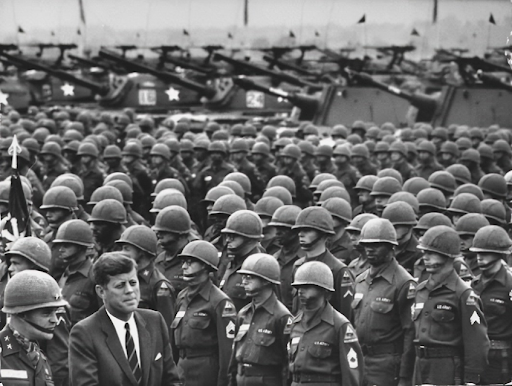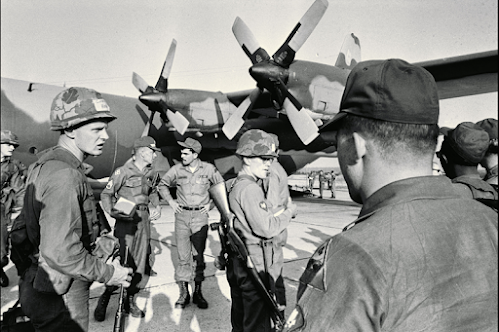THE U.S. ARMY AND VIETNAM: THE BEGINNING
Some would argue that "the U.S. Army lost the Vietnam war before the first field formations set foot in that country." One argument is that in 1965 'the U.S. Army was unprepared and unable to meet the challenges imposed by the Vietnam War.'
Andrew Krepinevich’s The Army and Vietnam is a critique of the U.S. Army and strategic/operational
leadership during the conflict in Vietnam (1959-1973). Krepinivich lays claim
that the senior leaders and commanders of the U.S. Army approached the conflict
in Vietnam in an inflexible, European Theater style ‘force-on-force’ strategy
that conscientiously ignored ‘counter-insurgency’ techniques and would
tactically, rely on maximum combined arms firepower to destroy the Viet Cong
insurgency and the North Vietnamese Army.
The Army and Vietnam draws
from the experiences of the U.S. Army during World War II and Korea.
Krepinevich presents details of the thinking of senior leaders between WWII and
Korea as well as after the Korean War. There is discussion of ‘The Army
Concept’, as Krepinevich illustrates, which was “basically, the Army’s
perception of how wars ought (authors
italics) to be waged and is reflected in the way the Army organizes and trains
its troops for battle.”[1] The illustrated point Krepinivich makes
is that the U.S. Army, reflecting on its own experiences of both World War II
and Korea, applied its ‘desires’ to the way Vietnam should have been fought
instead of performing analysis, incorporating flexibility both strategically
and operationally, and ultimately approaching the issues and challenges of
Vietnam by tailoring her forces for the uniqueness of the campaign.
Instead,
the Army simply deployed both formations and an organizational mindset much
more suited for a combined arms conflict across Europe to the jungles of
Vietnam. The Army’s objectives in principle are “to find, to fix, and to
destroy the enemy.” This, to senior Army leaders was the key task for both conventional and unconventional
conflicts.
The Army and Vietnam makes
the effective argument that the key planners for the Vietnam War, General
William Westmoreland and the staff of the Military Assistance Command Vietnam
(MACV) all simply massaged a strategy based off of ‘how the U.S. Army’ was
organized prior to the conflict as opposed to conducting a thorough analysis of
the enemy first, and then organizing the U.S. involvement based off of the
analysis. “MACV simply developed a strategy to suit the Army’s modus operandi,
force structure, and doctrine.”[1]
Krepinevich’s
thesis appears to be validated on some counts as he lays out the discussion
of strategy from sourced reports and conversations between the Johnson
administration, General Wheeler, the Chairman of the Joint Chiefs of Staff as
well as the Defense Secretary Robert McNamara and Westmoreland in Vietnam. Any
good examination of counterinsurgencies focuses in on defining the insurgency,
understanding the insurgency ‘center of gravity’ or focus, and the
counterinsurgents force make up and force ratio of counter insurgents to
insurgents. And Krepenivich provides that key planners from the very beginning
of the Vietnam involvement understood accurately, the challenges that they
would face. And ultimately, how they often ignored the reality favoring their
firepower and maneuver centric approach to combined arms warfare.
The Army and Vietnam’s most
damning and powerful arguments are made in chapter 7; ‘Counterinsurgency
American Style.’ The U.S. involvement essentially followed a theme that
Krepinevich outlines; a large Western military, overly reliant on technology
and firepower arrives, forces the ARVN to reorganize in a slighter image of its
visiting U.S. Army. This coupled with
the formulation of a strategy based on how the U.S. Army was organized for war
in Europe, while ignoring the realities of South Vietnam and its insurgency.
This was dubiously followed up by counterinsurgency tactics that relied on
firepower, searching for large ‘enemy formations’ to annihilate and missed the
most obvious and critical aspect of any insurgency; protecting the populace.
MACV and
Westmoreland decided early on to run two separate commands in South Vietnam.
MACV and the U.S. would focus on ‘finding, fixing, and destroying’ the Viet
Cong in the field. The ARVN would be charged with protecting the populace. And
neither two commands would be mutually supporting. The avoidance of the most
fundamental principles in counterinsurgency; unity of command and protecting
the populace would be avoided in the main and relegated to the least effective
force for the whole of the war.
The inner
workings of the U.S. Army in Vietnam brought to bear a recipe for disaster.
Draftees were rotated in and out of Vietnam every 12 months, thus denying the
most basic formations such as the Platoon and Rifle Company, any modicum of
cohesion and esprit. Officers were rotated every six months from Platoon
Command to Battalion Staff positions. “In a 1976 survey of officers conducted
at the Army’s Command and General Staff College, only 8% of Vietnam veterans
stated burnout was a factor at the end of their six months’ command; the
majority felt that frequent changes in command were detrimental to morale and
discipline.”[1]
To
further add to the malaise that was the U.S. Army in Vietnam, U.S. advisors
were almost held in contempt once large U.S. main force Divisions arrived
in-country. The perception, very quickly, was that the advisors were of a lower
quality than those operating as U.S. Company and Battalion Commanders. Also operating along the margins of the ‘big’
U.S. Army in Vietnam were Special Forces, State Department ‘CORDS’ (Civil Operations
and Revolutionary Development Support) pacification program and a host of other
agencies, projects, and personnel. The irony was that those outside the main
U.S. Army force structure in Vietnam (U.S. Divisions) were almost exclusively
focused on ‘counterinsurgency’ principles such as protecting the populace,
village economic development, education training, and pacification. Meantime,
MACV was focused on large scale operations with the ‘body count’ metric
providing proof of progress in ‘destroying the enemies will or ability to
fight.’
Krepinevich and The Army and Vietnam makes a compelling argument for the failures
of many key leaders and planners of the Vietnam involvement. The sacrifices
made by hundreds of thousands of American youth, to include the over 58,000
U.S. Americans killed in action, had to be attributed to someone, and
culpability rests with President Johnson and his coterie of attendants from the
Joint Chiefs of Staff to General Westmoreland dispatched to MACV and South
Vietnam. “True to its Concept, the Army focused on the technological dimensions
of strategy while ignoring the political and social dimensions that formed the
foundation of counterinsurgency warfare.”[1] And thus, the 10-year war that
resonates and influences the U.S. Army even today. It most likely will for
some time to come given the challenges of the contemporary Army today.
However, refreshed arguments from contemporary scholars including Mark Moyar (Triumph Forsaken: The Vietnam War 1954-1965) and the trilogy from Gregory Daddis (No Sure Victory, Westmoreland's War, and Withdrawal) force us to acknolwedge that one, the Vietnam war is an incredibly complex mosaic, and that two, no matter often scholars try, no simple argument or thesis is enough to fully explain or offer an understanding of the Vietnam war.
CITATION
KREPINIVICH,
ANDREW F., THE ARMY AND VIETNAM, JOHNS HOPKINS UNIVERSITY PRESS, 1986.









Comments
Post a Comment